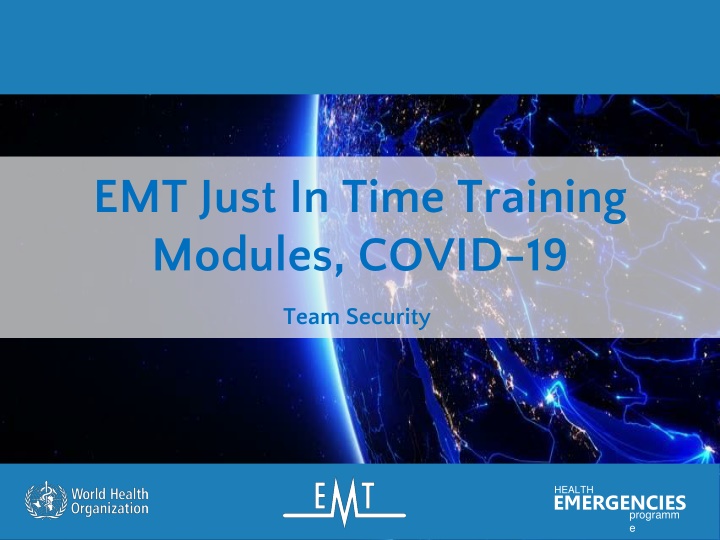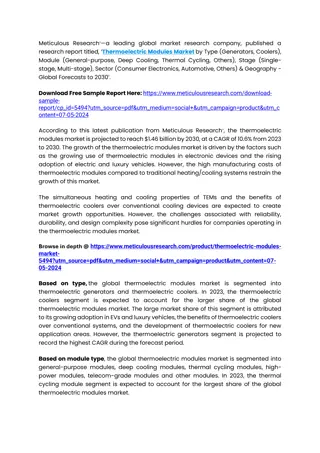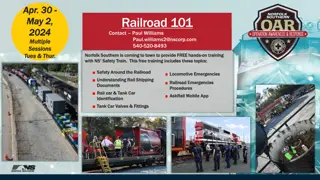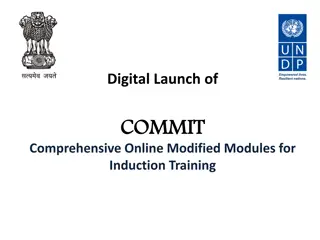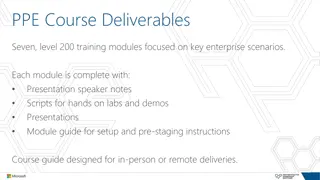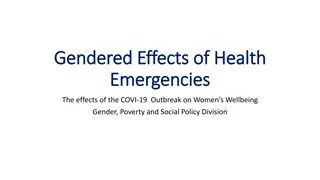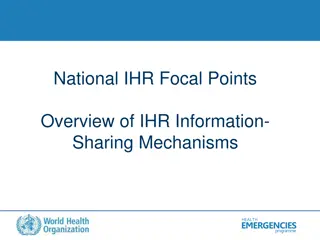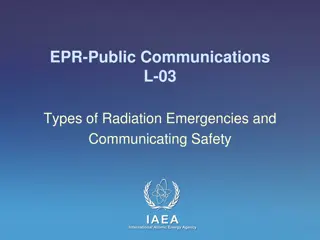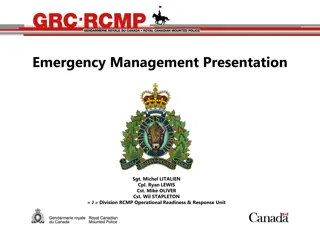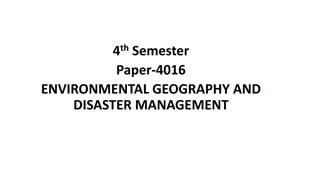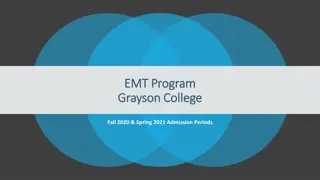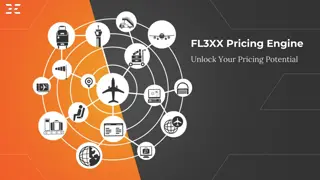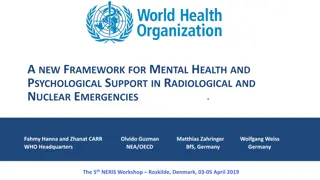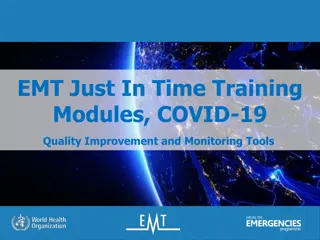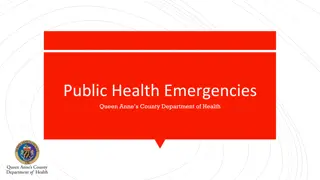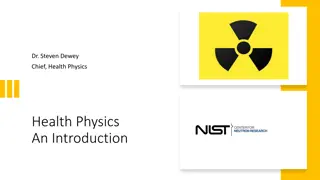EMT Just-In-Time Training Modules for Health Emergencies: COVID-19 Team Security Program
This program focuses on preparing EMT personnel for surge roles during health emergencies, specifically in COVID-affected communities. It outlines duty of care policies, security concerns reporting channels, security plan components, staff exposure reduction techniques, and crowd management principles application. The program emphasizes security measures amid pandemic-related challenges and the complexities of handling international deployments, overloaded national capacities, varied health facility approaches, non-medical support staff affiliations, and potential threats in conflict settings.
Download Presentation

Please find below an Image/Link to download the presentation.
The content on the website is provided AS IS for your information and personal use only. It may not be sold, licensed, or shared on other websites without obtaining consent from the author.If you encounter any issues during the download, it is possible that the publisher has removed the file from their server.
You are allowed to download the files provided on this website for personal or commercial use, subject to the condition that they are used lawfully. All files are the property of their respective owners.
The content on the website is provided AS IS for your information and personal use only. It may not be sold, licensed, or shared on other websites without obtaining consent from the author.
E N D
Presentation Transcript
EMT Just In Time Training Modules, COVID-19 Team Security HEALTH EMERGENCIES HEALTH EMERGENCIES programm e programm e
Session Outcomes Outline relevant Duty of Care policies and the EMT organization s degree of risk appetite in respect of its personnel working in surge roles Identify the channels for reporting security concerns when operating in COVID affected communities List the key components of a security plan, including specific planning for hibernation and extraction of personnel due to escalating security risks Apply techniques for reducing staff exposure to criminality when surged into new surroundings Explain how crowd management principles can be applied to prevent and defuse gatherings of people HEALTH EMERGENCIES programm e
Whats Not Covered Here Specific protective measures relating to infectious disease Rather, the focus here is on other security threats that, in some local contexts, have been exacerbated by the emergence of a pandemic HEALTH EMERGENCIES programm e
Who is responsible for the security of EMT personnel while working as surge support in the COVID response? The primary responsibility for the security and protection of relief workers, their dependents and assets rests with the host government ? HEALTH EMERGENCIES programm e
Additional considerations which complicate Duty of Care responsibilities International deployment Overwhelmed national capacity Variations in approach between local health facilities Non-medical support staff may belong to different parental organisations In conflict settings, host authorities may be a source of threat HEALTH EMERGENCIES programm e
Conclusion: In the absence of a comprehensive, systemic approach to Duty of Care, the EMT organisation must have a robust set of security procedures and measures of its own in place, adapted to the local context. This is important, whether the individuals are co-located or distributed across more than one facility. Likewise, individual staff members have a vital role to play, they need to be properly informed and skilled in the individual / team security practices required of them. HEALTH EMERGENCIES programm e
The EMT Organisations Approach to Duty of Care [Trainer to insert relevant points here, as befits the organisational approach. Include the mechanism by which EMT team members are required to report security incidents and near misses what, how, how urgently, and to whom] HEALTH EMERGENCIES programm e
Security planning exercise Plans are nothing, planning is everything HEALTH EMERGENCIES programm e
You are tasked with writing the security plan for your team operations The majority of your personnel are involved in running a community treatment centre on the outside of the capital city. Additionally, you are providing small numbers of clinicians as surge support to larger hospitals in different parts of the city. On a single flipchart, list as many elements of your plan as you can You don t have to write the plan, just list the essential elements that would be included. Be specific! Examples: Immediate steps that staff should take in case of a security incident Location of assembly areas Phone numbers of immediate responders etc HEALTH EMERGENCIES programm e
Local time is 1200hrs. Civil unrest has erupted near your community treatment facility between rival groups. Tension is spreading to the outskirts of the city and the government security forces are responding aggressively. You must pass instructions to all teams & staff quickly. To do so, you must have updated staff lists. Do you have updated staff lists? If yes: the task takes 1 hr If no: the task takes 2 hrs Extra credit: do you have a warden system or information tree? If yes: the task takes 0 hrs HEALTH EMERGENCIES programm e
Your instructions are for people to move to their designated safe areas, as indicated in the security plan Have you indicated designated safe areas? If yes: the task takes 1 hr If no: the task takes 2 hrs HEALTH EMERGENCIES programm e
As team members may have to wait in their safe areas for some time, they may need emergency supplies (food, water, medical) Have emergency supplies been planned for? If yes: the task takes 1 hr If no: the task takes 2 hrs HEALTH EMERGENCIES programm e
You try to call your HQ but all phone lines are down. You will use the backup means of communications listed in the communications plan. Do you have a communications plan? If yes: the task takes 1 hr If no: the task takes 2 hrs HEALTH EMERGENCIES programm e
Instructions from HQ are to evtract/relocate non-essential staff. You will do this in accordance with the evacuation plan. Do you have an extract/relocation plan? If yes: the task takes 1 hr If no: the task takes 2 hrs HEALTH EMERGENCIES programm e
Local health providers will need to continue operations. They will do this in accordance with the plan for continuity of operations, which your team will support remotely. Do you have a plan for continuity of operations? If yes: the task takes 1 hr If no: the task takes 2 hrs HEALTH EMERGENCIES programm e
A problem has arisen: the primary means of extraction is no longer available. You will have to use an alternative. Have you identified an alternative means of extraction, including secondary (back up) routes? If yes: the task takes 1 hr If no: the task takes 2 hrs HEALTH EMERGENCIES programm e
Carrying out the evacuation will require national government coordination (escorts, for example). At a minimum, you will need to know how to contact key officials. Have you planned for host nation coordination? If yes: the task takes 1 hr If no: the task takes 2 hrs HEALTH EMERGENCIES programm e
Local news stations are reporting a building collapse in one of the city hospitals causing damage and loss of services. Four of your staff were working there, one of whom has been seriously injured. You want to coordinate her transfer immediately, but do not know which are the safe routes. You plan to consult the map in your security plan. Does your security plan include a map? If yes: the task takes 1 hr If no: the task takes 2 hrs HEALTH EMERGENCIES programm e
Final time for your team? HEALTH EMERGENCIES programm e
Key ingredients: what should a good security plan contain? Overview of the situation and risk assessment Contact info for key personnel Updated staffing lists A communications plan Team security standard operating procedures Maps, safe routes & safe houses Emergency assembly areas Host nation liaison Medical support plan Plans for specific contingencies - including extraction, hibernation and continuity of operations HEALTH EMERGENCIES programm e
Dealing with criminal threats Criminality is a constant threat in any society and doesn t disappear during times of pandemics. Some criminal elements may seek to intentionally exploit the situation e.g. identity fraud, domestic or gender-based violence. As basic resources (e.g. food) grow short, increase in petty theft, looting or other unplanned acts out of desperation. EMT personnel must therefore act with continued situational awareness this is especially difficult when tired, stressed and (for surge responders) when operating in a local context that was unknown to them previously. HEALTH EMERGENCIES programm e
Crowd management for EMTs responding to COVID Crowd situations can be challenging for health facilities to deal with during sudden onset disasters However, during the COVID pandemic, the needs and motivation of crowds differ, e.g.: Fear and confusion Lack of, or conflicting, information Increased reports of aggressive behaviour channeled towards foreign relief workers Examples of violent tactics used by security forces to enforce lockdown and disperse civil unrest See the following for latest incident security bulletin: http://insecurityinsight.org/projects/aid-in-danger/aid-security-and-covid-19 HEALTH EMERGENCIES programm e
EMT Mobile Operations You are part of a mobile assessment team who is visiting remote communities to identify their medical needs during the pandemic. The first 3 towns you visit are peaceful and well organised. However, when you reach the 4thtown, word has spread before you and a large gathering of people quickly surround your vehicles. The community leader greets you and explains that the community is in desperate need of relief items (food, clean water, shelter provision) and they have been expecting your arrival to start the distribution. 2. What actions would you follow in this scenario to manage the crowd in terms of: a. Pre-empt? b. Defuse? c. Contain? HEALTH EMERGENCIES programm e
EMT Fixed Facility Operations There are 2,000 internally displaced persons (IDPs) currently located in a temporary settlement with a further 300 expected to arrive soon. It has been advertised to the local population and IDPs that your EMT facility will be arriving to begin patient registration and triage operations on Wednesday morning. On Tuesday evening, however, you are advised that the numbers for new arrivees were grossly underestimated, and that closer to 3,000 additional IDPs will be showing up for treatment the following morning. 1. Would you go ahead with your medical relief operations on Wednesday? 2. If so, what actions would you follow to manage the crowd in terms of: a. Pre-empt? b. Defuse? c. Contain? HEALTH EMERGENCIES programm e
A. Preempt Avoid encouraging people into crowds unless you are sure of meeting their expectations Plan: understand the context and needs of the crowd choose appropriate time and location plan the physical spacing in waiting areas remove dangerous objects contingency plans Rehearse scheduled events HEALTH EMERGENCIES programm e
B. Defuse Avoid entering crowds Separate leaders where possible to seek win-win solutions Keep others informed & comfortable during negotiations HEALTH EMERGENCIES programm e
C. Contain As medical relief teams, we should be gone by this stage. Recognise the escalation signs as civil unrest increases, and make decisive decisions Ensure all team members are clear on the exit plan when and how to disconnect Advance planning and liaison with local security forces is needed Be aware that different security forces will respond in a variety of ways HEALTH EMERGENCIES programm e
Summary Governments have overall Duty of Care responsibility but, especially during pandemics, this is a challenge, and therefore everyone has a role to play in contributing to security risk management. Management has additional responsibilities, these must be applied even if EMT personnel are seconded to multiple health facilities. One of the key tools is to develop a practical security plan that is tailored to the risks present in the local environment. Security plans are strongest when developed as a collective management should involve and inform team members as much as possible. Specific threats in times of pandemics don t disappear. The EMT organisation should have specific measures in place to deal with criminality and crowd unrest. HEALTH EMERGENCIES programm e
Thank you Any questions? For more http://extranet.who.int/e mt/ EMTeams@who.i nt HEALTH EMERGENCIES programm e
